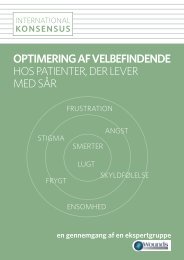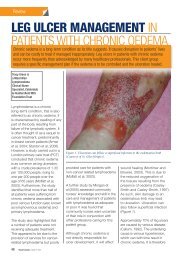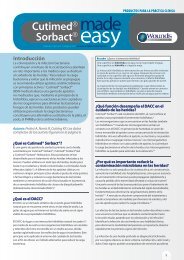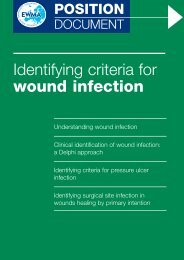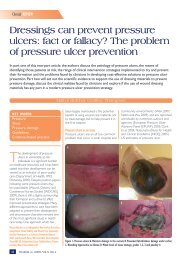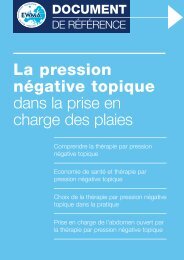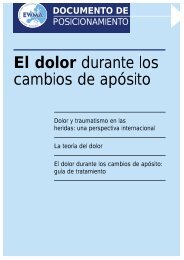best practice guidelines: wound management in diabetic foot ulcers
best practice guidelines: wound management in diabetic foot ulcers
best practice guidelines: wound management in diabetic foot ulcers
- No tags were found...
Create successful ePaper yourself
Turn your PDF publications into a flip-book with our unique Google optimized e-Paper software.
DFU WOUNDMANAGEMENTTABLE 6: Wound <strong>management</strong> dress<strong>in</strong>g guideType of tissue <strong>in</strong> the<strong>wound</strong>Necrotic, black,drySloughy,yellow, brown,black or greyDry to lowexudateSloughy,yellow, brown,black or greyModerate to highexudateGranulat<strong>in</strong>g,clean, redDry to lowexudateGranulat<strong>in</strong>g,clean, redModerate to highexudateEpithelialis<strong>in</strong>g,red, p<strong>in</strong>kNo to lowexudateInfectedLow to highexudateTherapeutic goal Role of dress<strong>in</strong>g Treatment optionsRemove devitalisedtissueDo not attemptdebridement if vascular<strong>in</strong>sufficiency suspectedKeep dry and refer forvascular assessmentRemove sloughProvide clean <strong>wound</strong>bed for granulationtissueRemove sloughProvide clean <strong>wound</strong>bed for granulationtissueExudate <strong>management</strong>Promote granulationProvide healthy <strong>wound</strong>bed for epithelialisationExudate <strong>management</strong>Provide healthy <strong>wound</strong>bed for epithelialisationPromote epithelialisationand <strong>wound</strong> maturation(contraction)Reduce bacterial loadExudate <strong>management</strong>Odour controlHydration of <strong>wound</strong>bedPromote autolyticdebridementRehydrate <strong>wound</strong>bedControl moisturebalancePromote autolyticdebridementAbsorb excess fluidProtect peri<strong>wound</strong>sk<strong>in</strong> to preventmacerationPromote autolyticdebridementMa<strong>in</strong>ta<strong>in</strong> moisturebalanceProtect newtissue growthMa<strong>in</strong>ta<strong>in</strong> moisturebalanceProtect newtissue growthProtect new tissuegrowthAntimicrobial actionMoist <strong>wound</strong> heal<strong>in</strong>gOdour absorptionWound bedpreparationSurgical or mechnicaldebridementSurgical or mechanicaldebridement ifappropriateWound cleans<strong>in</strong>g(consider antiseptic<strong>wound</strong> cleans<strong>in</strong>gsolution)Surgical ormechanical debridementif appropriateWound cleans<strong>in</strong>g(consider antiseptic<strong>wound</strong> cleans<strong>in</strong>gsolution)Considerbarrier productsWound cleans<strong>in</strong>gWound cleans<strong>in</strong>gConsiderbarrier productsWound cleans<strong>in</strong>g(consider antiseptic<strong>wound</strong> cleans<strong>in</strong>gsolution)Consider barrierproductsPrimarydress<strong>in</strong>gHydrogelHoneyHydrogelHoneyAbsorbent dress<strong>in</strong>g(alg<strong>in</strong>ate/CMC/foam)For deep <strong>wound</strong>s, usecavity strips, rope orribbon versionsHydrogelLow adherent (silicone)dress<strong>in</strong>gFor deep <strong>wound</strong>s usecavity strips, rope orribbon versionsAbsorbent dress<strong>in</strong>g(alg<strong>in</strong>ate/CMC/foam)Low adherent (silicone)dress<strong>in</strong>gFor deep <strong>wound</strong>s, usecavity strips, rope orribbon versionsHydrocolloid (th<strong>in</strong>)Polyurethane filmdress<strong>in</strong>gLow adherent (silicone)dress<strong>in</strong>gAntimicrobial dress<strong>in</strong>g(see Table 5 for comb<strong>in</strong>edpresentations)Secondarydress<strong>in</strong>gPolyurethane filmdress<strong>in</strong>gPolyurethane filmdress<strong>in</strong>gLow adherent(silicone)dress<strong>in</strong>gRetention bandageor polyurethanefilm dress<strong>in</strong>gPad and/orretention bandage.Avoid bandagesthat may causeocclusion andmaceration. Tapesshould be usedwith caution dueto allergy potentialand secondarycomplicationsThe purpose of this table is to provide guidance about appropriate dress<strong>in</strong>gs and should be used <strong>in</strong> conjunction with cl<strong>in</strong>ical judgement andlocal protocols. Where <strong>wound</strong>s conta<strong>in</strong> mixed tissue types, it is important to consider the predom<strong>in</strong>ant factors affect<strong>in</strong>g heal<strong>in</strong>g and addressaccord<strong>in</strong>gly. Where <strong>in</strong>fection is suspected it is important to regularly <strong>in</strong>spect the <strong>wound</strong> and to change the dress<strong>in</strong>g frequently.Wound dress<strong>in</strong>gs should be used <strong>in</strong> comb<strong>in</strong>ation with appropriate <strong>wound</strong> bed preparation, systemic antibiotic therapy, pressure offload<strong>in</strong>gand <strong>diabetic</strong> controlBEST PRACTICE GUIDELINES: WOUND MANAGEMENT IN DIABETIC FOOT ULCERS 15




